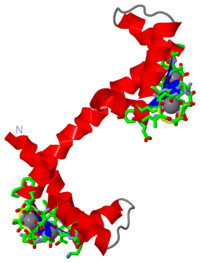Calcium-free Calmodulin
From Proteopedia
| |||||||||
| 1cfc, 25 NMR models () | |||||||||
|---|---|---|---|---|---|---|---|---|---|
| Related: | 1cfd | ||||||||
| |||||||||
| |||||||||
| |||||||||
| Resources: | FirstGlance, OCA, RCSB, PDBsum | ||||||||
| Coordinates: | save as pdb, mmCIF, xml | ||||||||
Calmodulin is a molecule that has been studied extensively in its functions within the cell, and has an important role in relaying Ca2+ signals within the cytosol. [1] It does this by binding to Ca2+, undergoing a conformational change, and may interact with various proteins within the cell.[1][2][3] It consists of 148 residues and is somewhat shaped like a dumbell, where one end is an N-terminal domain, the other end is the C-terminal domain, and they are connected by a link of about 5 residues. [2] It is also part of the "EF hand" superfamily, named after the pair of helix-loop-helix motifs present in its N and C domains. [2] Once bound to a target protein, it undergoes a further conformational change and may activate certain systems. For example, there is a Ca2+ pump in the plasma membrane pump that is activated by the binding of Ca2+-bound calmodulin, and then uses ATP to drive the Ca2+ out of the cell. [4]
Contents |
Calcium-bound Calmodulin
The structure of calcium-bound calmodulin had previously been discovered using x-ray crystallography. [3] It was then theorized that knowledge of the structure of calcium-free calmodulin would give greater insight into the function of the protein. Attempts were made to crystallize the calcium-free (or apo) form, but to no avail, thus it was decided that the only way to get a good idea of the structure would be to use several NMR experiments. [2]
Calcium-free Calmodulin
The structure of calcium-free calmodulin was discovered by doing several different NMR experiments that included ROE, reverse labelling of Phe residues, and 3-bond J-couplings. [2] It was theorized that by comparing the results of the NMR experiments for the apo calmodulin with the calcium-bound calmodulin, information could be gleaned as to the structural changes that occur when calcium is bound. It was discovered that the series of residues from Met76 to Ser81 which comprised the flexible link between the N-terminal domain and the C-terminal domain were in a helical form in apo calmodulin, but not in calcium-bound calmodulin. [2] This conclusion was supported by experiments with proteases that digested this region in the calcium-bound state, but not the apo state, meaning that this region is protected in the apo state. [5] These findings suggested that when calcium binds to both domains on calmodulin, a conformational change occurs that involves the unwinding of this helical arrangement. [2] It was further inferred that when calcium binds to calmodulin, the resulting conformational change creates hydrophobic pockets on the surface of the N and C domains which were not present in the apo state. [2][6] There are proteins with similar structures to calmodulin, and troponin was in fact used as a comparison model, as it was highly homologous (51% sequence identity)to calmodulin. [2]
3D structure of Calcium-free calmodulin
See apo CaM in Calmodulin
References
- ↑ 1.0 1.1 Hoeflich, K.P., & Ikura, M.. Calmodulin in action: diversity in target recognition and activation mechanisms, Cell. 2002 108:739-742
- ↑ 2.0 2.1 2.2 2.3 2.4 2.5 2.6 2.7 2.8 Kuboniwa H, Tjandra N, Grzesiek S, Ren H, Klee CB, Bax A. Solution structure of calcium-free calmodulin. Nat Struct Biol. 1995 Sep;2(9):768-76. PMID:7552748
- ↑ 3.0 3.1 Babu YS, Bugg CE, Cook WJ. Structure of calmodulin refined at 2.2 A resolution. J Mol Biol. 1988 Nov 5;204(1):191-204. PMID:3145979
- ↑ Berridge MJ, Bootman MD, Roderick HL. Calcium signalling: dynamics, homeostasis and remodelling. Nat Rev Mol Cell Biol. 2003 Jul;4(7):517-29. PMID:12838335 doi:10.1038/nrm1155
- ↑ Angela M. Gronenborn and G. Marius Clore. Identification of N-terminal helix capping boxes by means of 13C chemical shifts. Journal of Biomolecular NMR, 4:1994
- ↑ Ikura, M et al. Solution structure of a calmodulin-target peptide complex by mulit-dimensional NMR. Science, 256:632-638
Proteopedia Page Contributors and Editors (what is this?)
Christopher Truscott, David Canner, Alexander Berchansky, Michal Harel, Andrea Gorrell



